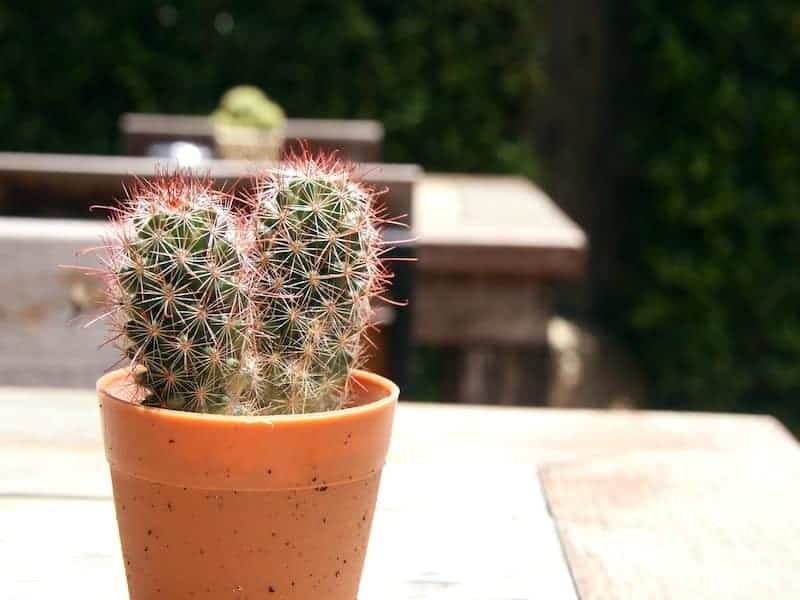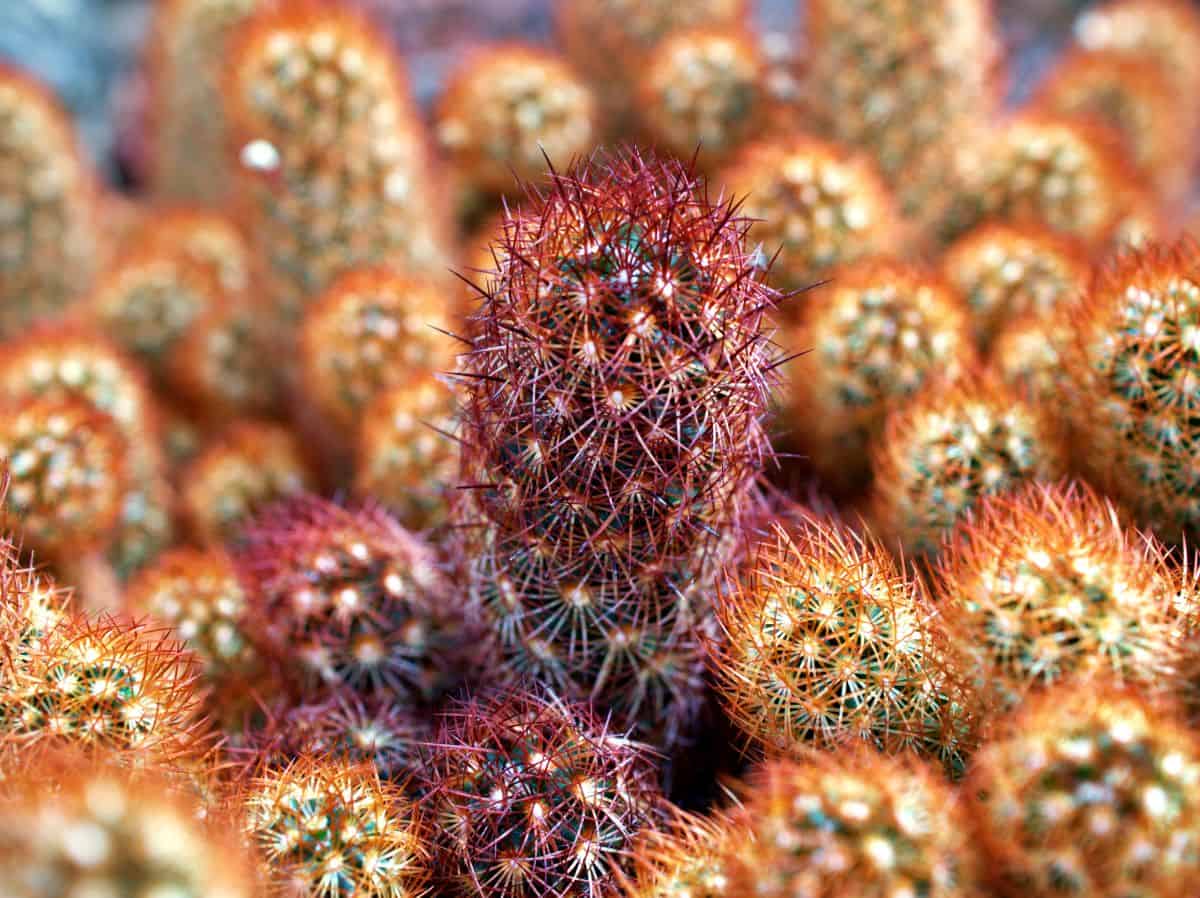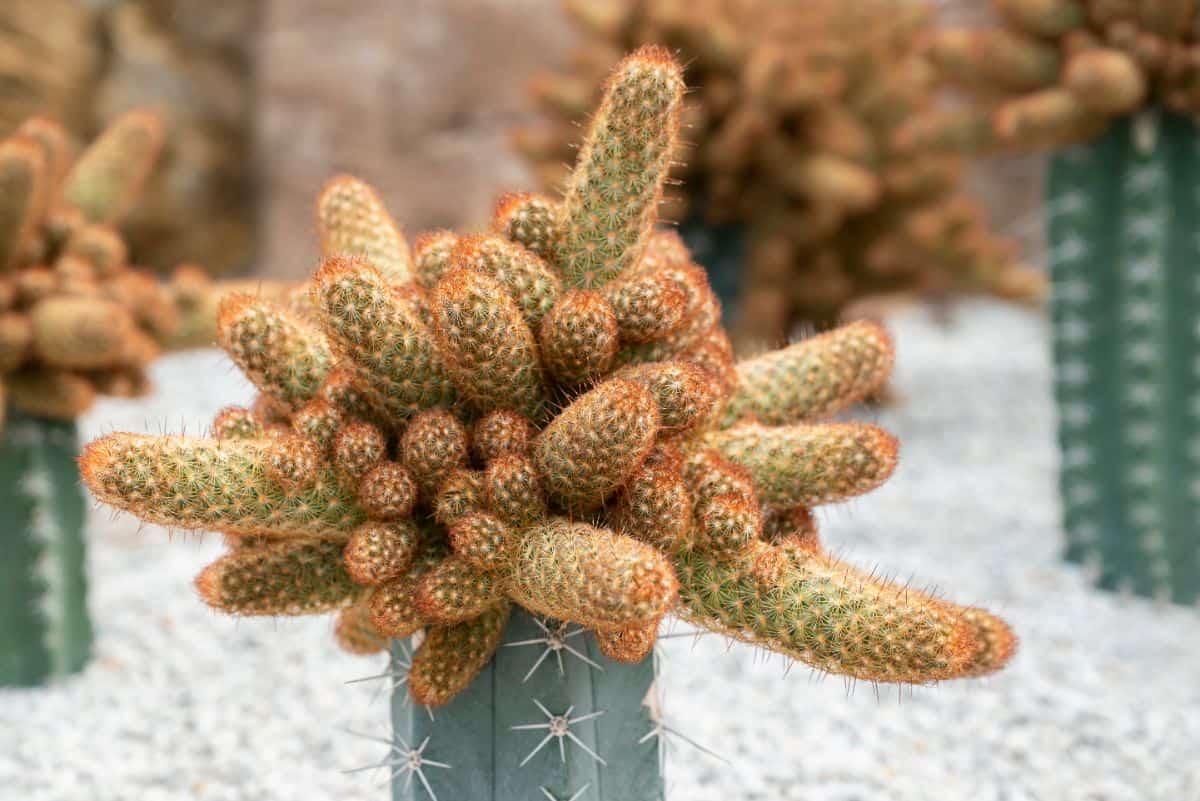The Lady Finger Cactus, or Mammillaria elongata goes by several different names. It’s also sometimes known as Golden Stars, Gold Lace Cactus, or simply Lady Fingers. It is a petite cactus native to central Mexico. This unique cactus gets its names from its elongated stems and golden yellow or brown spines.

The Lady Finger Cactus is a favorite among cactus gardeners because of its showy white, yellow, or pink blooms. It’s even earned the Royal Horticultural Society’s Award of Garden Merit in the United Kingdom.
Jump to:
Lady Finger Cactus Appearance
| Name: | Mammillaria elongata |
| Soil: | Well-draining soil |
| Blooming: | Mid-winter to late spring |
| Light: | Bright light |
| Water: | When the soil is dry |
| Propagation: | Offsets, cutting and seeds |
As the name suggests, M. elongata is an elongated cactus with a cylindrical stem. The stems can reach up to 6 inches in length and average just over an inch in diameter. The stems are covered in white or gold recurved spines. The Lady Finger Cactus is a clumping cactus that grows in tight clusters.

Buy it from:
In spring, the Lady Finger Cactus produces petite white, yellow, or pink flowers. The flowers are sometimes solid in color, but they may also flush pink or have pink stripes. The blooms emerge from the axils of the cactus’ tubercles.
Cultivars
Though rare, there are a few cultivars of the Lady Finger Cactus that can be found by the determined cactus lover. Though they are not as common as the original variety, they are highly sought after by collectors.
Mammillaria elongata ‘Monstrous Lady Fingers’
The monstrous form of Lady Fingers somewhat resembles the original in shape, but the stems are shorter and nearly spineless. This variety tends to grow more slowly than the original and can be more difficult to bloom.
However, when it does bloom, it produces beautiful flesh-colored flowers that are flushed with pink.
Mammillaria elongata ‘Copper King’
The Copper King cultivar is nearly identical to the original variety except for the color of the spines. As the name suggests, they are a deep copper color, rather than the traditional white or gold.
When Copper King blooms in the spring, it produces petite yellow or pink flowers that may or may not be flushed with pink.
Caring for Lady Finger Cactus
The Lady Finger Cactus is popular among cactus gardeners of all experience levels and for good reason. It’s relatively easy to care for species, so long as it receives the right type of care.
Like most cacti, it prefers a more hands-off approach, but when treated right, it will reward you with beautiful flowers. In some cases, the Lady Finger Cactus may even bloom a second time later in the year.
No products found.
Light

As with most Mammillaria, Lady Fingers does best when grown in bright light if kept indoors. A south-facing window is ideal, but an east or west-facing window should also suffice. This is not a plant that will do well in low light environments.
If your indoor space doesn’t provide enough sunlight for your Lady Finger Cactus, you may want to consider supplementing with a grow light. Grow lights are typically quite easy to manage and will provide your succulents and cacti with enough light to grow and flourish, even in the dimmest apartments or office spaces.
When grown outdoors, it’s best to provide your Lady Fingers with full sun if possible. However, be sure to introduce increased light levels slowly to avoid sunburning your cactus. These cacti love sunlight, but too much too soon can permanently damage your precious plant.
Instead of sticking your cactus outside for a full day right away, slowly increase the amount of time spent in the direct sun over a period of several weeks. This way, your Lady Fingers has time to adapt without risking its health and appearance.
Water
The Lady Finger Cactus prefers to be watered deeply, but infrequently. Overly wet soil for prolonged periods of time and standing water should be avoided at all costs. The Lady Finger Cactus is native to the arid climate of central Mexico, so keep that in mind when watering your cactus.
To encourage better blooming, it’s important to cut back watering during the winter. This helps the cactus enter a period of dormancy, which isn’t entirely necessary for plants kept indoors, but it can assist the cactus in flower production.
You should also be cautious about watering on a schedule without considering the weather or season. During particularly hot weather, the soil is likely to dry out more quickly and need more frequent watering.
During cool temperatures or humid weather, be sure to reduce the frequency of watering to prevent accidental overwatering. Overwatering can result in root rot, so it’s best to make sure the soil is allowed to dry out completely before watering.
Temperature
Mammillaria elongata is not a frost-tolerant plant, so if you’re keeping it outdoors and expect temperatures to dip below 30 degrees Fahrenheit, it’s best to bring your cactus inside. If planted in the ground outdoors, be sure to cover your cacti to prevent freezing.
Though cooler temperatures can be tolerated during periods of dormancy, Lady Finger Cacti will not survive freezing temperatures. If you grow your Lady Fingers indoors, temperatures are likely to be more consistent, but try to protect your cacti from sudden temperature changes or drafts if possible.
Soil

Lady Finger Cacti are like most species of cacti in that they require soil that allows for plenty of drainage. Remember, excess moisture will eventually lead to root rot, so you need to make sure you plant your cactus in soil that allows that unneeded water to drain away.
Avoid soils with high amounts of water-retaining matter such as clay, peat moss, or coconut coir. Small amounts of these ingredients aren’t likely to make a huge difference in drainage, but you should choose a soil that mostly consists of larger particles that promote drainage.
When shopping for a commercial soil, consider one labeled specifically for use with cacti and succulents. These soils typically have more sand, gravel, perlite, or bark to help with drainage and airflow.
Of course, if you’re the DIY type, you might consider mixing your own cactus soil. Again, try to avoid ingredients that will encourage water retention.
Mammillaria can be slow-growing cacti, so don’t expect to have to repot your Lady Fingers frequently. However, if your cactus has been in the same soil for a long time, consider adding a water-soluble plant food during the growing season.
Container
If you’ve chosen the right type of soil, you’ll need to make sure you choose the right type of container for your Lady Finger Cactus. No matter how well draining your soil mixture may be, if your container doesn’t allow excess water to escape, your cactus is still at risk of root rot.
If you can’t be convinced to give up that adorable pot without the drainage hole, you’ll need to be incredibly careful about your watering schedule. Or you could always drill a hole in the pot.
Whatever you do, be sure that excess moisture can drain away from your cactus’ roots. You should avoid lining the bottom of the pot with rocks, too. This won’t promote drainage and will instead create a perched water table, which will keep the water closer to your plant’s roots.
When it comes to cacti, drainage is key, especially if you have a tendency to overwater your plants. Though it won’t save your cacti from frequent overwatering, good drainage will help it recover from the occasional dose of too much water.
Propagating Lady Finger Cactus

Not only is the Lady Finger Cactus easy to grow, but it’s also easy to propagate. Even if you have little experience propagating cacti, you should be able to grow new Lady Fingers with minimal effort.
Whichever method you use, be sure to use safe cactus handling techniques. Though the spines of M. elongata tend to curve back toward the spine, they can still be sharp if your fingers catch them at the right angle.
It’s recommended to wear gloves or use tools such as chopsticks, towels, or newspaper to safely handle your cacti and prevent any injuries to you or the cactus.
Offsets
The most common method of Lady Finger Cactus propagation is by separating offsets. As a clumping species of cactus, a single stem will quickly be surrounded by smaller offsets. These can then be separated and grown in different containers.
Most offsets can be separated by gently tugging them away from the mother plant. Just be sure to protect your hands from the spines. You can also cut them away using a sharp, clean knife, but be sure to cut the offset away as close to the mother plant as possible.
Once separated, it’s recommended to allow the offsets to dry out for a few days to allow any wounds to callous. This will help prevent infection and give your offsets the best chance of survival.
After they’ve calloused, your new Lady Fingers can be planted in their new container. They can then be treated just as you did the mother plant.
Cuttings
It’s also possible to propagate Lady Finger cacti with cuttings. These cacti do occasionally grow small branches that can easily be separated from the stem, or you can take a stem cutting.
Whichever you choose, be sure to cut the cactus using a sharp, clean pair of scissors or shears. Sharp tools will make clean cuts and prevent infection and damage to your cactus. Again, be sure to protect your hands from the spines.
As with offsets, you’ll need to give the cuttings a few days to callous before you can move them to their new container. Once they’ve calloused, you can plant them in their new container. After a few days or weeks, tiny roots should begin to develop.
You can encourage faster rooting by dipping each cutting into rooting hormone powder prior to planting. This isn’t a necessary step, but it is helpful for impatient gardeners who don’t enjoy waiting for their tiny cacti to produce roots.
Seeds
Growing Lady Finger Cacti from seeds is possible, but it’s an extremely slow process, which is why it’s not done as frequently as the other two propagation methods.
However, if you’re looking for a project, you can either collect seeds from your existing Lady Finger Cactus or purchase them on the internet.
Some gardeners recommend soaking the seeds prior to planting, but it’s a personal choice. Once you’re ready to sow the seeds, be sure to do so in moist, well-draining cactus soil. Keep the soil moist until you begin to see tiny cactus sprouts.
After the seedlings have appeared, you can allow the soil to dry out a bit more to prevent rot. It’s not recommended to repot the seedlings until they’re big enough to handle safely without accidentally damaging the cacti or their root systems.
Common Pests and Problems

The Lady Finger Cactus isn’t any more prone to pests than any other type of cacti, but it’s important to monitor them regularly for infestations. Most pests have short life cycles, which means their population can explode in a matter of weeks.
The more pests you have to deal with, the harder the infestation will be to treat and the more time-consuming treatment will be. For this reason, it’s best to check your plants regularly so you can begin to treat them as soon as possible.
While you may not need to water your Lady Fingers every week, you should still give them a once over to make sure that no creepy crawlies have decided to move in. Without prompt treatment, pests can permanently damage or even kill a plant.
It’s also recommended that you quarantine any new plants you bring into your household for at least a week or two before setting them near your existing collection. This gives any pests enough time to make their presence known.
Treating a few new plants for pests is much easier than treating your entire garden, so while it may be annoying to keep your new plants separated, it’s definitely worth it. If you’re unfamiliar with common pests, read our guide here.


